For a number of two-stroke engine aficionados the Yamaha 350YPVS engine delivered the epitome of 80s power and performance. It also holds a special place in the heart of certain scooterists too…
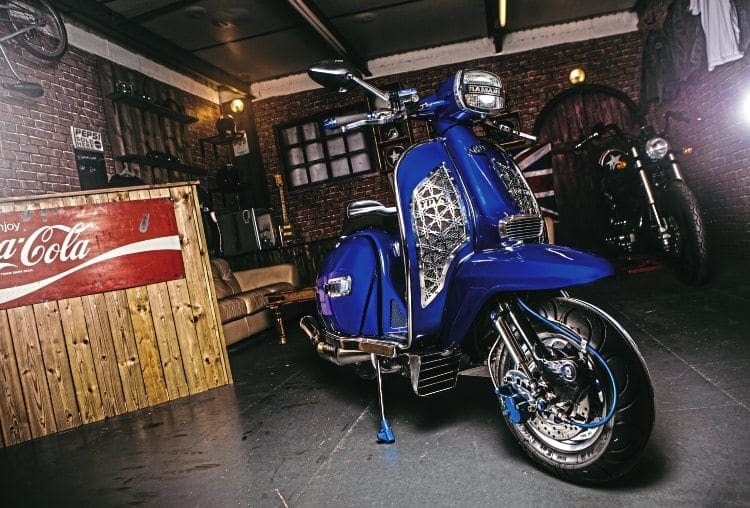
Col Barrett, who rides with Dorset Lowriders SC has been on the periphery of the scooter scene for many years. It was the 90s when he was in Canada when he attended a few scooter rallies. Later that same decade after returning to the UK he got his first scooter, a Lambretta GP, with a 240cc top end. He has also been an active member of the rare soul scene, which has always had a degree of crossing over into the scooter scene. Col numbers among those who regard the Yam 350 YPVS as the pinnacle of the 80s two-stroke power.

“I always had a bit of a soft spot for the Rossa 350 Yarn-Lams, even in standard specifications. Those power-valve engines have always amazed me, they are the ultimate 80s two-stroke engines. The concept behind the creation of Old Blue comes from the Rossa Yam-Lams of the 80s. I’ve had a few bikes, getting more interested in scooters in the 90s. The ultimate scooter to me, as a younger man, was the Rossa. With my 50th birthday approaching, I decided to treat myself to a Yamaha 350 YPVS engined scooter.”
Two for the price of one
Back in 2014, after doing his own due diligence so to speak, Col commissioned Gary Hancox of GWH Restorations to build him a Yamaha 350 YPVS powered full bodied Lambretta. “Gary Hancox is an absolute engineering genius,” he said. “He also completed the initial build of Old Blue, including the paintwork prep and subcontracting out the paintwork in an amazingly short time. The paint code is R1 which is the exact shade of deep purple metallic blue colour used by Yamaha. I always fancied a scooter painted that colour, the name Old Blue part relates to the paint, and as for the ‘Old’, it was 30 years ago the RD engined Rossa first appeared.
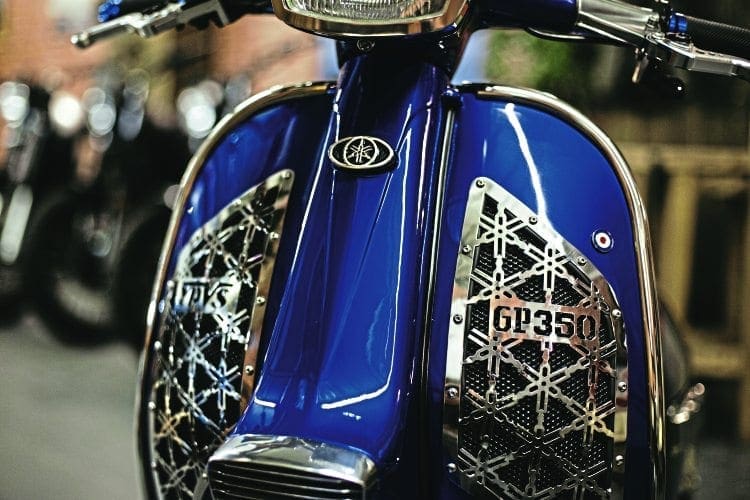
“Gary did a fantastic job with his reworking of the frame, re-siting certain fittings, fabricating many one-off items and as a by-product of his superb workmanship, Old Blue looks as good fully dressed as she does undressed. Gary’s work on creating the frame allowed me to have a few extras added to it. I’m equally happy riding her with everything on display as I am with full panel work fitted. I’d recommend Gary at GWH Restorations to anyone, he’s a master engineer.”
Cool Off
Old Blue is powered by a standard Yamaha 350 YPVS motor which was first stripped and thoroughly checked, then items were replaced where necessary with new parts before rebuilding. All of which was meticulously carried out by Mark Wheeler at AII2Wheelers in Poole, Dorset. The only deviation from factory spec in the engine department is a set of aftermarket Jim Lomas exhaust pipes.
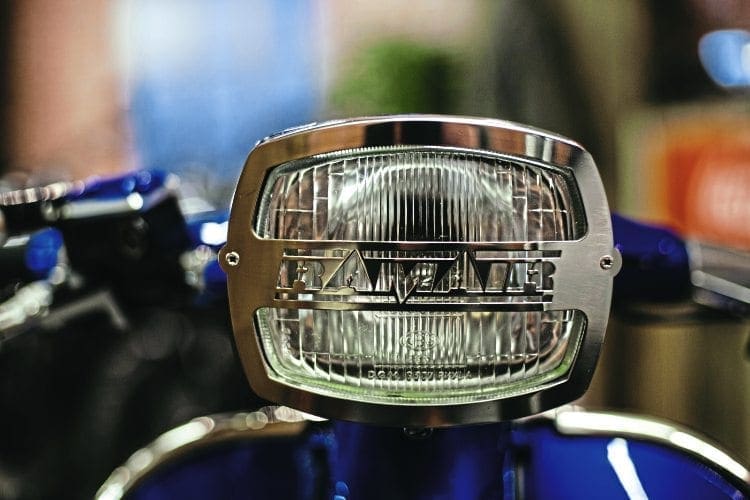
After Gary Hancox had completed the build Col decided on changing a few bits and pieces. Which, along with Mark Wheeler’s hands-on input resulted in the scooter Old Blue is now.
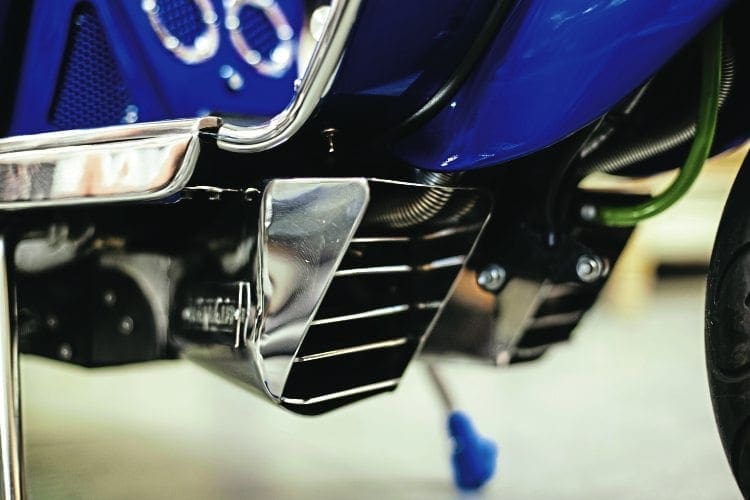
“Cooling on Old Blue didn’t seem to work too well,” said Col. “I wasn’t convinced that having the radiator under the legshields where it was sited originally would be efficient enough. I didn’t want to have the radiator relocated to be mounted on the front of the legshields, I’ve seen a few with that setup, personally, I don’t like how it looks. Me and Mark Wheeler had a look and a brainstorming session. The result was to move the rad’ to inside the legshield glovebox.
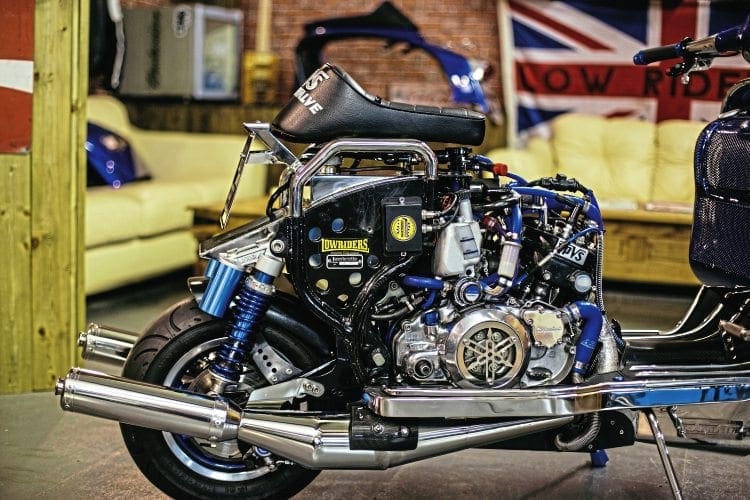
“At that point, the fuel tank was located inside the glovebox, which meant the tank would need moving. Logically the tank would move under the seat. Except, what was probably the optimum place for the tank was partly occupied by electrical components. I spent two days measuring and re-measuring, making a template for a new tank that utilised every spare millimetre. Electrics were moved from inside to outside the frame. A larger radiator was located inside the glovebox, to ensure the airflow to it is both efficient and constant there are symmetrical cutaways in the legshields, as well as a pair of forced air scoops that direct air into the engine compartment.
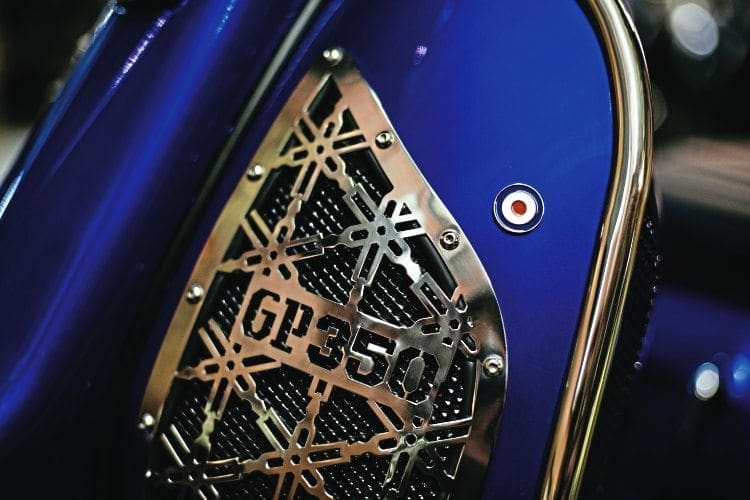
“As additional back up I have had an auxiliary fan fitted, which hasn’t been used as yet. Old Blue runs well, though maybe too cool at times. When first starting up I allow a bit of time for her to warm up properly before riding.”
Turning My Heartbeat Up
Functionality, as well as appearance, is a combination aimed for by just about everyone embarking on a scooter project. Getting the two aspects to combine isn’t as straightforward as it may seem, certainly in some cases. When Old Blue was at the pre-build stage, Col had it in mind to keep it simple, subscribing to a less-is-more philosophy. He decided on a colour scheme combination of the Yamaha purple-blue metallic paintwork enhanced with black and stainless steel. Keith Newman at K2 Custom provided all the stainless steel items, including the subtle laser cut lettering.
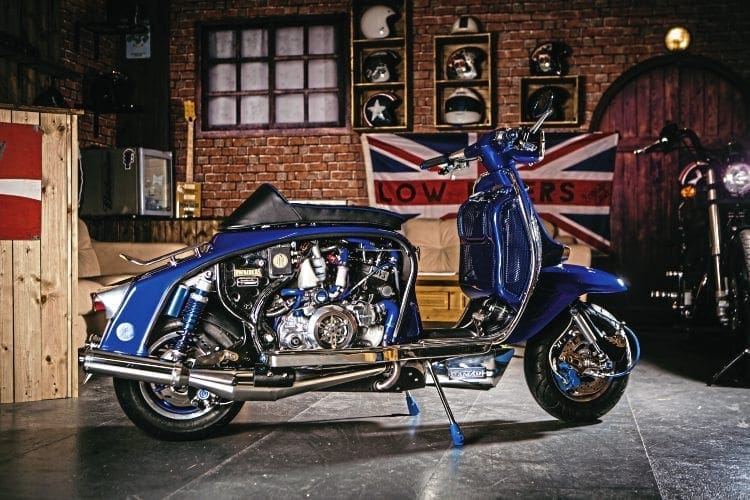
Col is especially happy with how the stainless coverings on the legshield cut-outs look, in effect giving an appearance of lungs, which allow the scooter to breathe. Ensuring the 350 YPVS delivered optimum power meant Col taking Old Blue to go through a Dyno Tune process. Which proved to be successful resulting in a 9bhp increase in the output. There are a few other modifications to Old Blue that aren’t blatantly obvious; barring one planned change Col is more than happy with his bespoke, Rossa-inspired Yam-Lam 350.

“Gary’s design of the frame, including easy removal of the bodywork, allowed me to design a frame for the seat that incorporates both the number plate and rear light. The Seat frame was made to my design by Elite Fabrications, which is local to me. Also, I’ve got two options when riding — with either the panels or bodywork removed, a bit like a cut-down. This makes accessibility a lot easier if any adjustments are needed. Quite a few people have commented they prefer her naked, personally, I prefer riding Old Blue with all her clothes on.
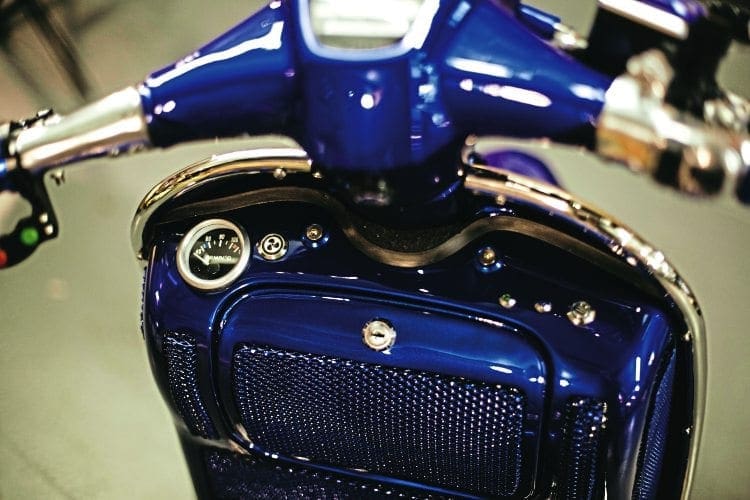
“It’s good to have options on how Old Blue appears. One change that will definitely be happening is fitting an electronic GPS style speedometer. At the moment I have a standard Lammy speedo, which is just about capable of registering how many miles I clock up and that’s about it. Speedo apart, I’m very pleased with Old Blue. Reliable, gobs of power across all the ranges, she’s an absolute dream to ride. Handling is both solid and stable, for quite a weighty scoot she’s good when cornering and at top speed.”
OWNER DETAILS
Name: Col Barrett
Job: Managing clerk of works.
Scooter club & town: Lowriders, Dorset.
How and when did you first become interested in scooters: Always been around scooters in some form or another but didn’t get interested or own my own until the 90s. Have been on the soul scene forever and as you know both these genres crossover in some form or another, so I guess it’s a matter of natural progression.
What was your first scooter: GP 200 with a 240 kit – fantastic scooter but not that rideable.
What is your favourite style of custom scooter: Off the wall unique, well engineered, cut downs, street racers, clean slick and fast.

First rally or event: Only recently became involved in the rally part of the scene although used to attend regular scooter events in the early 90s while living abroad in Vancouver BC.What’s your funniest experience with a scooter: Leaving the kickstart at home on the Yambretta; needless to say I had to turn around on a limited fuel tank.
What do you like about rallies/events: Array of different scooters, people, social side.
What’s your favourite Scootering magazine feature: The custom features especially the ones involving water-cooled two-stroke twins!
Your favourite custom/featured scooter of all time: I really enjoyed the recent Small Frame Big Heart Vespa RG250 Gamma feature in October 2017… well done Aubrey, nice.
What’s the most useless part you’ve ever bought for one of your scooters: Stainless fork boots!
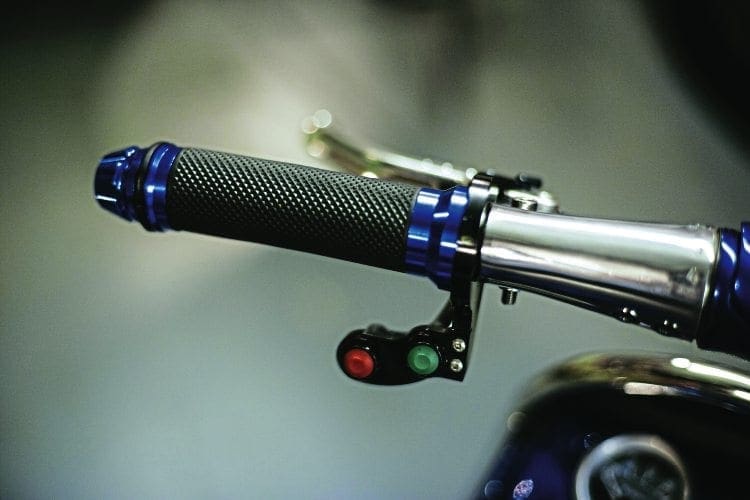
SCOOTER DETAILS
Name of scooter: ‘Old Blue’.
Scooter model: GP 200.
Inspiration for project: Always had a soft spot for the Rossa 350s of the 80s.
Time to build & by who: Surprisingly quick but with me changing bits and pieces it’s only recently been finished. Built by Gary Hancox.
Any specialised parts or frame mods: Majority of the mods have been carried out by Gary Hancox of GWH Retro Renovations scooter builders. Engine totally standard apart from pipes and pod filters but totally rebuilt by Mark Wheeler of All2Wheelers Poole. Elite Fabrication of Poole constructed the naked seat frame.
Engine spec: RD 350 YPVS Standard.
Crank: Rebuilt by Grampian.
Carb: Original.
Exhaust: Pretty sure these are Jim Lomas pipes.
Clutch: Genuine Yamaha.
Gearbox: Shift pro fitted to selector. Klicktronic solenoid changer.
Are there any other unique details we have missed: Old Blue looks fantastic with no clothes on and she’s a damn sight easier to work on naked, especially jetting adjustments. This allowed me to design a seat frame incorporating the number plate light and kick start holder and to use the design of Gary’s frame as a base for the set frame. I’m now able to ride Old Blue as a standard-looking fully clothed scooter or bollock naked as a cut down/skelly, this makes jetting adjustments so much easier plus looks pretty cool showing off her bits!
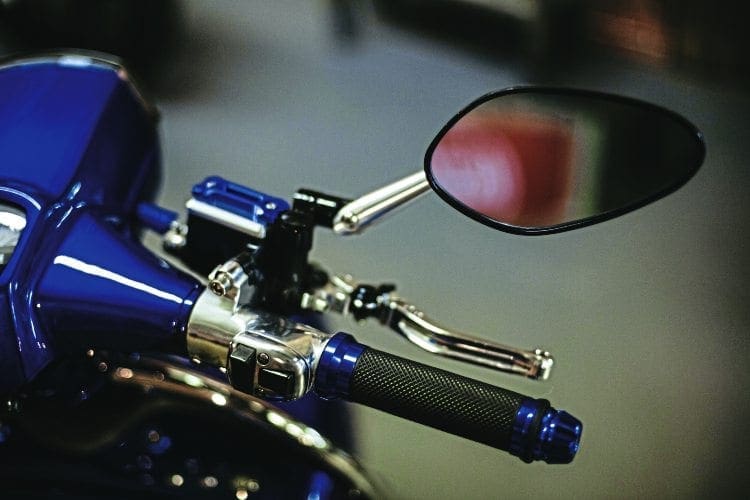
Top speed & cruising speed: Original Lambretta speedo is way off the mark so unable to accurately predict exact speed. The RD350 YPVS were good for 100mph+ and I reckon I’ve come close. Cruises nicely.
Is the scooter reliable: Extremely now all teething problems have been ironed out. Paintwork & murals done by: Paint code is actually the very same as the R1 which is Deep Purple Metallic Blue and I reckon looks better on Old Blue because of the lack of decals. I was told ‘less is more’ and I really think it works with Old Blue.
Overall cost: My wife reads Scootering (Sue Barrett) so… I picked it up at a car boot for just under a grand!
What was the hardest part of the project: Paying for it! No seriously, I think it would have to be the cooling, these RD twins produce a hell of a lot of heat.
Do you have any advice or tech tips for anyone starting a project: An understanding partner and bank manager. Don’t think you’re going to get a production machine over night with no glitches or adjustments. Prepare to get your own hands dirty and embrace others’ advice. Above all don’t give up.
Is there anyone you wish to thank: Gary Hancox of GWH retro renovations scooter builders for a start as his concept of a Yambretta is second to none. Mark Wheeler of All2Wheelers in Poole Dorset — the man’s a marvel with engines. Keith Newman of K2customs who made and laser cut all my Stainless Steel, still love the LUNGS. Elite Fabrication of Poole for fabricating the seat frame and polishing the tank.
BUILDING THE BEAST
Anyone embarking on a scooter project that requires an abundance of engineering know-how along with specialised, bespoke items manufactured as one-offs has two choices open to them. Either, if you possess the prerequisite skills and facilities go for it yourself. Alternatively, enlist the services of an expert. Col opted for the latter and Gary Hancox who runs GWH Restorations is without question a very capable engineer. He has built himself a formidably impressive reputation along with some 30 seriously well-engineered scooters, including one that’s powered by a Honda Silverwing engine.
We managed to grab a quick chat with Gary about his huge input in the creation of Old Blue: “Colin came to me with his idea of a Rossa inspired, 350 YPVS engine Lambretta. One of the inherent problems encountered when going for a similar conversion is to not change the angle that the engine is designed to sit at. If it’s not level it goes without saying things such as oil levels will not be as they should. When fabricating the engine cradle I had to cut and slide the pivot so the engine sat as it was intended (in a Yamaha).
“Another dimension that on some similar conversions hasn’t been adhered to is the wheelbase dimensions from spindle to spindle. Stick to 51 to a maximum of 54 inches and an RD engined Lammy will handle like a dream, anything beyond that can and will adversely affect the handling. I did the entire, initial build of Colin’s Yam-Bretta, including prepping it all ready for painting. Originally the radiator was situated under the legshields, which is where its meant to be located as well as it helps with aerodynamics. Colin has since changed the location of the radiator and replaced the fuel tank. I don’t know who put it in his head to move the rad and the tank, still it’s his scooter. When he took it to be set up on the dyno, it was done with the panels off, it should have been done with them on. As I’ve mentioned it’s Colin’s scooter so what he does with it is up to him, I think how it’s now set up will concentrate maximum heat around the carbs with the panels on, which may cause a few problems will the temperature it runs at.
“When I build a scooter I build them so even a stupid person can take it to bits. I’ve built 30 scooters so far, I love the challenge of building trick scooters.”
DYNO EXPERIENCE
Col on dynos: “I took it to be dynoed on a recommendation, as it was proving to be a bit of a job to get it right. It was okay-ish, though running lean. It was a very thorough process, going through and giving attention to just about everything. I was on changing jet duties, going from something like a 350 to 420 size main jet. Over the course of the dyno session, the engine increased from 37bhp to 48bhp. It’s more or less a standard RD350 YPVS engne, with the exception being the exhaust pipes, which I’m fairly certain are Jim Lomas pipes.
“Although after having it dyno’d it’s increased to 48bhp, top speed is under the 100mph plus that a stock Yamaha RD350 YPVS delivers. I reckon she gives close to 100mph top speed, and more importantly cruises along nicely, which is probably due to keeping the motor pretty much to standard specifications.”
ROSS YAM-BRETTA 350 RETROSPECTIVE
In the 80s, along with then business partner Alan Rosser, Frank Sanderson, came up with a hybrid water-cooled scooter. Eventually marketed as the Rossa 350, the machine consisted of a modified Lambretta frame that took a Yamaha 350YPVS engine. As the Yamaha engine was liquid-cooled, another requirement was a cooling system. Frank parted company with Alan Rosser during the short lived, but significant, ‘production’ of Rossa 350 scooters. Thirty years or so down the line, hard facts about the Rossa 350 are still thin on the ground and, it seems, shrouded in mystery.
What is known is that some of the Rossa 350 scooters suffered with both final drive issues and problems with overheating. The idea of a 350YPVS powered Lambretta, despite the aforementioned niggles, was a concept that appealed to those scooterists with an insatiable need for speed. A prototype version of the Rossa made an appearance at Morecambe rally in ’89. It certainly impressed some of the scooterists who witnessed it ripping up and down the seafront. There are differing views on exactly how many Rossa 350 scooters were completed. Markus, occasional freelancer for Scootering, owns an original Rossa, his being either number 13 or 14.
Alan Rosser took deposits of £1000 against future Rossa scooters, orders from customers literally buying into the Rossa 350 concept. He then disappeared, apparently to Australia, with a sizable amount of cash. After returning to the North East of England, Alan Rosser, so the story goes, was kidnapped on several occasions, before being shot dead. No-one has been caught or charged with the shooting. Updated and revised takes of the Rossa probably number more than genuine Rossa scooters still around. Engineering over the past decade or two has accelerated to new levels, what proved to be problematic 30 years ago is much more straightforward to sort out these days.
Words: Sarge
Photographs: Gary Chapman



